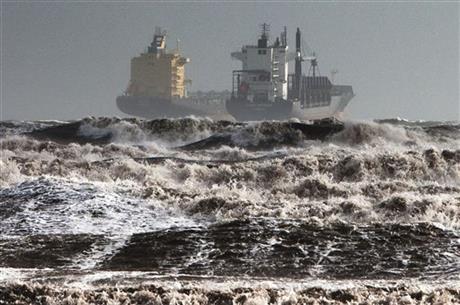
By NICOLE WINFIELD
Two tankers are battered by gale winds while at the roadstead in the rough waters of the Gulf of Cagliari, Sardinia, Monday, Nov. 18, 2013. A violent rainstorm that flooded entire parts of the Mediterranean island of Sardinia has led to the deaths of at least nine people. Bridges were felled by swollen rivers and water levels reached 3 metres (yards) in some places. (AP Photo/Max Solinas)
Italy Storm
Rescuers work in a flooded street in the small town of Uras, Sardinia, Monday, Nov. 18, 2013. A violent rainstorm that flooded entire parts of the Mediterranean island of Sardinia has led to the deaths of at least nine people. Bridges were felled by swollen rivers and water levels reached 3 metres (yards) in some places. (AP Photo/Alessandra Chergia)
Italy Storm
Two men use an inflatable dingy to get around in a flooded street in Olbia, northern Sardinia, Monday, Nov. 18, 2013. A violent rainstorm that flooded entire parts of the Mediterranean island of Sardinia has led to the deaths of at least nine people. Bridges were felled by swollen rivers and water levels reached 3 metres (yards) in some places. (AP Photo/Antonio Satta)
Prev
1 of 3
Next
ROME (AP) — The Mediterranean island of Sardinia, prized by the jet-set for its white sand beaches and crystal-clear seas, was a flood-ravaged mud bath Tuesday after a freak torrential rainstorm killed at least 17 people, downed bridges and swept away cars.
Italian Premier Enrico Letta declared a state of emergency and set aside 20 million euros ($27 million) for emergency relief, saying the priority was reaching remote areas, saving the lives of those still unaccounted for and providing for those left homeless. Letta later traveled to the island, where he met with people hit by the floods.
The island, which draws royals, entrepreneurs and ordinary tourists alike during the dry, peak summer months, received more than 44 centimeters (17.3 inches) of rain in 24 hours Monday — half the amount it normally receives in a year, officials said.
Italy’s civil protection chief, Franco Gabrielli, said the death toll may still rise as crews reach isolated areas in the countryside where some homes are submerged.
Pope Francis said in a message posted on Twitter that he was “deeply moved by the appalling tragedy that hit Sardinia.” He asked followers to offer prayers to the victims, “especially for the children.”
Transport was hampered by rivers of cocoa-colored mud gushing over roads that forced the closure of several major thoroughfares, including a tunnel into the city of Olbia, according to the Anas company which runs Italy’s roads and highways.
Olbia Mayor Gianni Giovannelli said the city had been destroyed by the “apocalyptic” storm, with bridges felled and water levels reaching 3 meters (10 feet) in some places. He described the ferocity of the storm’s rains as a “water bomb.”
Gabrielli defended the civil protection’s alert system, which had signaled an “elevated” risk of the storm on much of Sardinia, the highest level of alert. He warned against day-after finger-pointing, saying evacuation orders had been issued and ignored and that no weather forecast could have predicted the “exceptional” degree of devastation.
Sardinia’s governor, Ugo Cappellacci, said the 17 dead included a family of four, reportedly of Brazilian origin, in Arzachena.
Local newspaper L’Unione Sarda said a policeman helping to escort an ambulance died when the car he was travelling in was submerged in the collapse of a bridge in Dorgali. In hard-hit Gallura, three people died after their car was swept away in the collapse of another bridge, the paper said.
Sardinia is the second-largest island in the Mediterranean and is one of Italy’s autonomous regions. While it’s known to tourists for its pristine Costa Smeralda beaches, the island’s interior is known for its sheep and pastoral life. Sardinians are famed for their exceptional longevity.
Other parts of Italy were also hit by heavy rains Tuesday, including the capital, Rome, and Venice in the north, where residents and tourists donned rubber boots to slosh through a St. Marks’ Square flooded from the “acqua alta” high tides that periodically submerge the lagoon city.



